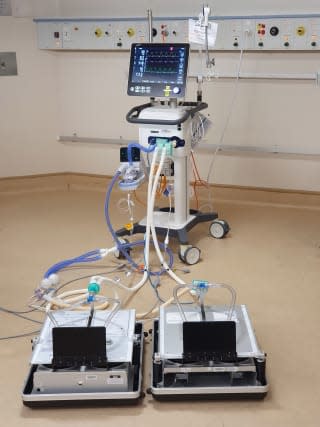Researchers try to find ways to deal with ventilator shortage

Scientists have found a way for more than one person to breathe from one ventilator as hospitals struggle to deal with a global shortage of the machines during the coronavirus pandemic.
Australian researchers from The Royal Women’s Hospital, Melbourne, Monash University and the Alfred Hospital, Melbourne, have successfully tested the practice of ventilator splitting.
It was done in a simulated environment, according to the study which is published in the international journal Anaesthesia.
Ventilators help push oxygen into patients whose lungs are failing and give the patient a chance to recover.
“Patients with Covid-19 may develop progressive viral pneumonitis leading to severe respiratory failure,” according to Dr Alexander Clarke, of The Royal Women’s Hospital in Melbourne who led the study.
The researchers stress they do not condone the practice of ventilator splitting but say the findings could offer hope it may be possible to use this method with standard hospital equipment to modify the pressure, flow and volume of air in each lung in an extreme emergency.
The key fact that patients will have different ventilation needs is among the challenges faced by this approach.
They could suffer cross-infection from inter-patient gas exchange and the lack of monitoring for individual tidal volume, flow and pressure is also a concern.
Irregularly pressurised air supply can kill patients, it is also noted.
Dr Clarke said: “Despite our advances in the practical application of ventilator splitting, the practice is unregulated and under tested.
“But as the Covid-19 pandemic continues to grow, some countries, like the USA, may consider ventilator splitting on compassionate grounds.
“The United States of America Food and Drug Administration has passed emergency use authorisation for the splitting of ventilators.
“While ventilator splitting has, at face value, validity in addressing ventilator shortages, we agree that on sober reflection, it is a solution that needs to be weighed up carefully as it may cause more harm than good.”
Dr Shaun Gregory, of Monash University, warned the findings should currently be treated with some caution.
He noted that “a resistance mechanism” had to be introduced in order to deliver a safe tidal volume and airway pressure.
Dr Gregory said: “While the discovery is promising, the use of this method in the clinical context has not been validated and we don’t recommend its wider use without further trials.
“We are hopeful of one day being able to get great surety with this approach to ventilator splitting so we can help save lives in dire cases of emergency.”


